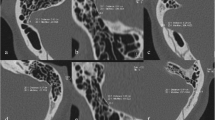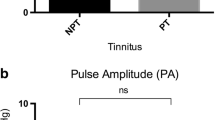Abstract
Background and Purpose
Lateral sinus stenosis is the most common cause of venous pulsatile tinnitus (VPT). Stenting is an effective treatment after demonstration of a trans-stenotic pressure gradient; however, pressure measurement has many technical limitations. In 2018, a study showed that a combined approach with intravascular velocity measurement could be effective in identifying most appropriate candidates for stenting. The aim of the present study was to evaluate a new strategy using this biomarker for the indication of stenting even without a significant pressure gradient.
Material and Methods
Consecutive patients with disabling VPT were included from 2016 to 2019 and analyzed retrospectively. Intrasinusal pressures were measured and blood flow velocities (with a dual-sensor guidewire) were used for the indication of stenting independent of the pressure gradient. We evaluated the clinical outcome after stenting based on this new biomarker.
Results
A total of 41 patients were treated according to this strategy. At last follow-up (mean = 30.2 months), 32/33 patients (97%) treated by stenting showed complete resolution or a significant decrease in VPT intensity. The use of velocity as the threshold for indicating stenting identified 8 patients (24%) missed by the pressure gradient. Their clinical outcome after stenting was excellent and no complications occurred.
Conclusion
Measurement of sinus blood flow velocity provides a hemodynamic explanation of disease and may be a better tool than pressure gradient for the indication of stenting in VPT.




Similar content being viewed by others
Abbreviations
- IIH:
-
Idiopathic intracranial hypertension
- LSS:
-
Lateral sinus stenosis
- RMV :
-
Mean blood flow velocity ratio
- TSG:
-
Trans-stenotic pressure gradient
- VAS:
-
Visual analogue scale
- VPT:
-
Venous pulsatile tinnitus
References
Sismanis A. Pulsatile tinnitus: contemporary assessment and management. Curr Opin Otolaryngol Head Neck Surg. 2011;19:348–57.
Hofmann E, Behr R, Neumann-Haefelin T, Schwager K. Pulsatile Tinnitus. 2013. https://www.aerzteblatt.de/10.3238/arztebl.2013.0451. Accessed 11 Feb 2021.
Abdalkader M, Nguyen TN, Norbash AM, Raz E, Shapiro M, Lenck S, Brinjikji W, Weber P, Sakai O. State of the Art: Venous Causes of Pulsatile Tinnitus and Diagnostic Considerations Guiding Endovascular Therapy. Radiology. 2021;300:2–16.
Pereira VM, Cancelliere NM, Najafi M, MacDonald D, Natarajan T, Radovanovic I, Krings T, Rutka J, Nicholson P, Steinman DA. Torrents of torment: turbulence as a mechanism of pulsatile tinnitus secondary to venous stenosis revealed by high-fidelity computational fluid dynamics. J Neurointerv Surg. 2021;13:732–7.
Nicholson P, Brinjikji W, Radovanovic I, Hilditch CA, Tsang ACO, Krings T, Mendes Pereira V, Lenck S. Venous sinus stenting for idiopathic intracranial hypertension: a systematic review and meta-analysis. J Neurointerv Surg. 2019;11:380–5.
Xue J, Li T, Sun X, Liu Y. Focal defect of mastoid bone shell in the region of the transverse-sigmoid junction: a new cause of pulsatile tinnitus. J Laryngol Otol. 2012;126:409–13.
Eliezer M, Freitas RK, Fantoni M, Guedon A, Houdart E. Selective embolization of the mastoid emissary vein for pulsatile tinnitus treatment: when is it indicated? J Neurointerv Surg. 2020;12:999–1001.
Houdart E, Chapot R, Merland JJ. Aneurysm of a dural sigmoid sinus: a novel vascular cause of pulsatile tinnitus. Ann Neurol. 2000;48:669–71.
Marks MP, Dake MD, Steinberg GK, Norbash AM, Lane B. Stent placement for arterial and venous cerebrovascular disease: preliminary experience. Radiology. 1994;191:441–6.
Mathis JM, Mattox D, Malloy P, Zoarski G. Endovascular treatment of pulsatile tinnitus caused by dural sinus stenosis. Skull Base Surg. 1997;7:145–50.
Satti SR, Leishangthem L, Chaudry MI. Meta-analysis of CSF diversion procedures and dural venous sinus stenting in the setting of medically refractory idiopathic intracranial hypertension. AJNR Am J Neuroradiol. 2015;36:1899–904.
Lenck S, Labeyrie MA, Vallee F, Saint-Maurice JP, Guillonnet A, Bernat AL, Vironneau P, Houdart E. Stent Placement for Disabling Pulsatile Tinnitus Caused by a Lateral Sinus Stenosis: A Retrospective Study. Oper Neurosurg (Hagerstown). 2017;13:560–5.
Labeyrie MA, Fantoni M, Vever U, Guedon A, Bonnin S, Bernat AL, Verillaud B, Houdart E. Intracranial venous sinus stenting for the treatment of lateral sinus stenoses: An analysis of 200 patients. Diagn Interv Imaging. 2021;102:619–27.
McDougall CM, Ban VS, Beecher J, Pride L, Welch BG. Fifty shades of gradients: does the pressure gradient in venous sinus stenting for idiopathic intracranial hypertension matter? A systematic review. J Neurosurg. 2018;130:999–1005.
Fargen KM, Liu K, Garner RM, Greeneway GP, Wolfe SQ, Crowley RW. Recommendations for the selection and treatment of patients with idiopathic intracranial hypertension for venous sinus stenting. J Neurointerv Surg. 2018;10:1203–8.
Avery MB, Sambrano S, Khader Eliyas J, Eesa M, Mitha AP. Accuracy and precision of venous pressure measurements of endovascular microcatheters in the setting of dural venous sinus stenosis. J Neurointerv Surg. 2018;10:387–91.
Raper DMS, Buell TJ, Chen C‑J, Ding D, Starke RM, Liu KC. Intracranial venous pressures under conscious sedation and general anesthesia. J Neurointerv Surg. 2017;9:986–9.
Fargen KM, Spiotta AM, Hyer M, Lena J, Turner RD, Turk AS, Chaudry I. Comparison of venous sinus manometry gradients obtained while awake and under general anesthesia before venous sinus stenting. J Neurointerv Surg. 2017;9:990–3.
Levitt MR, Albuquerque FC, Gross BA, Moon K, Jadhav AP, Ducruet AF, Crowley RW. Venous sinus stenting in patients without idiopathic intracranial hypertension. J Neurointerv Surg. 2017;9:512–5.
Levitt MR, Hlubek RJ, Moon K, Kalani MY, Nakaji P, Smith KA, Little AS, Knievel K, Chan JW, McDougall CG, Albuquerque FC. Incidence and predictors of dural venous sinus pressure gradient in idiopathic intracranial hypertension and non-idiopathic intracranial hypertension headache patients: results from 164 cerebral venograms. J Neurosurg. 2017;126:347–53.
Yang IH, Pereira VM, Lenck S, Nicholson P, Orru E, Klostranec JM, Krings T, Tsang ACO. Endovascular treatment of debilitating tinnitus secondary to cerebral venous sinus abnormalities: a literature review and technical illustration. J Neurointerv Surg. 2019;11:841–6.
Lenck S, Vallée F, Civelli V, Saint-Maurice JP, Nicholson P, Hong A, Houdart E. Assessment of blood flow velocities and venous pressures using a dual-sensor guidewire in symptomatic dural sinus stenoses. J Neurosurg. 2019:130:1992–6.
Mollan SP, Davies B, Silver NC, Shaw S, Mallucci CL, Wakerley BR, Krishnan A, Chavda SV, Ramalingam S, Edwards J, Hemmings K, Williamson M, Burdon MA, Hassan-Smith G, Digre K, Liu GT, Jensen RH, Sinclair AJ. Idiopathic intracranial hypertension: consensus guidelines on management. J Neurol Neurosurg Psychiatry. 2018;89:1088–1100.
Pegge SAH, Steens SCA, Kunst HPM, Meijer FJA. Pulsatile tinnitus: differential diagnosis and radiological work-up. Curr Radiol Rep. 2017;5:5.
Bathla G, Hegde A, Nagpal P, Agarwal A. Imaging in pulsatile tinnitus: case based review. J Clin Imaging Sci. 2020;10:84.
Liang L, Korogi Y, Sugahara T, Ikushima I, Shigematsu Y, Takahashi M, Provenzale JM. Normal structures in the intracranial dural sinuses: delineation with 3D contrast-enhanced magnetization prepared rapid acquisition gradient-echo imaging sequence. AJNR Am J Neuroradiol. 2002;23:1739–46.
Leach JL, Jones BV, Tomsick TA, Stewart CA, Balko MG. Normal appearance of arachnoid granulations on contrast-enhanced CT and MR of the brain: differentiation from dural sinus disease. AJNR Am J Neuroradiol. 1996;17:1523–32.
Guédon A, Labeyrie MA, Civelli V, Saint-Maurice JP, Houdart E. Navigability of a long sheath in the lateral dural sinuses facilitated by the pilot balloon technique: technical note. Neuroradiology. 2021;63:2149–51.
Cortese J, Eliezer M, Guédon A, Houdart E. Pulsatile Tinnitus Due to Stenosis of the Marginal Sinus: Diagnosis and Endovascular Treatment. AJNR Am J Neuroradiol. 2021;42:2194–8.
Ding H, Zhao P, Lv H, Li X, Qiu X, Zeng R, Wang G, Yang Z, Gong S, Jin L, Wang Z. Correlation Between Trans-Stenotic Blood Flow Velocity Differences and the Cerebral Venous Pressure Gradient in Transverse Sinus Stenosis: A Prospective 4-Dimensional Flow Magnetic Resonance Imaging Study. Neurosurgery. 2021;89:549–56.
Baomin L, Yongbing S, Xiangyu C. Angioplasty and stenting for intractable pulsatile tinnitus caused by dural venous sinus stenosis: a case series report. Otol Neurotol. 2014;35:5.
Su H, Li B, Wang J, Tian C, Cao X, Du Z, Liu X, Liu R, Yu S. Headache attributed to cranial venous sinus stenting: A case series and literature review. Cephalalgia. 2019;39:1277–83.
Li Y, Chen H, He L, Cao X, Wang X, Chen S, Li R, Yuan C. Hemodynamic assessments of venous pulsatile tinnitus using 4D-flow MRI. Neurology. 2018;91:e586–93.
Li X, Qiu X, Ding H, Lv H, Zhao P, Yang Z, Gong S, Wang Z. Effects of different morphologic abnormalities on hemodynamics in patients with venous pulsatile tinnitus: A four-dimensional flow magnetic resonance imaging study. J Magn Reson Imaging. 2021;53:1744–51.
Zhang Y, Ma C, Liang S, Li C, Zhu H, Li Z, Miao Z, Tong X, Dong K, Jiang C, Sui B, Mo D. Estimation of venous sinus pressure drop in patients with idiopathic intracranial hypertension using 4D-flow MRI. Eur Radiol. 2022. https://doi.org/10.1007/s00330-022-09199-z. Epub ahead of print.
Garner RM, Aldridge JB, Wolfe SQ, Fargen KM. Quality of life, need for retreatment, and the re-equilibration phenomenon after venous sinus stenting for idiopathic intracranial hypertension. J Neurointerv Surg. 2021;13:79–85.
Author information
Authors and Affiliations
Contributions
A. Guédon, T. Checkouri, F. Vallée, E. Houdart: designed and conceptualized study, acquisition of data, analyzed and interpreted the data, drafted the manuscript for intellectual content. M. Fantoni, V. Civelli, M.-A. Labeyrie, J.-P. Saint-Maurice: revised the manuscript for intellectual content.
Corresponding author
Ethics declarations
Conflict of interest
A. Guédon, T. Checkouri, M. Fantoni, V. Civelli, M.-A. Labeyrie, J.-P. Saint-Maurice, F. Vallée and E. Houdart declare that they have no competing interests concerning the materials or methods used in this study or the findings specified in this paper.
Ethical standards
All procedures performed in studies involving human participants or on human tissue were in accordance with the ethical standards of the institutional and/or national research committee and with the 1975 Helsinki declaration and its later amendments or comparable ethical standards. The study was approved by the institutional review board and patient informed consent was waived.
Additional information
Alexis Guédon and Thomas Checkouri contributed equally to the work.
Availability of Data and Material
The data that support the findings of this study are available from the corresponding author upon reasonable request.
Supplementary Information
Rights and permissions
Springer Nature or its licensor (e.g. a society or other partner) holds exclusive rights to this article under a publishing agreement with the author(s) or other rightsholder(s); author self-archiving of the accepted manuscript version of this article is solely governed by the terms of such publishing agreement and applicable law.
About this article
Cite this article
Guédon, A., Checkouri, T., Fantoni, M. et al. Blood Flow Velocity: a Decision Tool for Stenting Indication in Venous Pulsatile Tinnitus. Clin Neuroradiol 33, 729–737 (2023). https://doi.org/10.1007/s00062-023-01268-0
Received:
Accepted:
Published:
Issue Date:
DOI: https://doi.org/10.1007/s00062-023-01268-0




